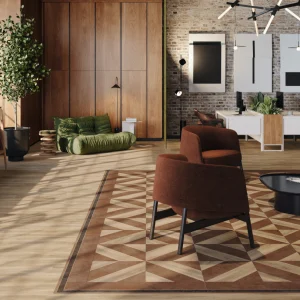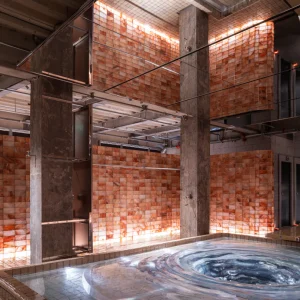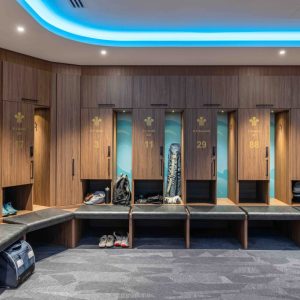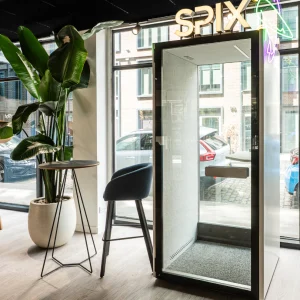
Earlier this year, a gathering of around 700 professionals interested in the impact of digital technology on the art and craft of designing and living gathered at Manchester’s Town Hall for the Future Everything festival’s two-day conference. Now on its 19th annual outing, the preoccupation of the festival’s founders – to celebrate the then fledgeling applications of digital culture – have become absolutely mainstream.
The conference audience wasn’t the geeky crowd you might once have expected. There were people with pink or shaved hair, more than a few Shoreditch ‘pilgrim father’ beards, a generous smattering of tattoos, a very strong representation of women and, age-wise, not just fresh-faced young techies/designers but a sizeable chunk of those between 30 and 50. As if to demonstrate the audience’s non- geekiness, the promise from one speaker to avoid mention of ‘biohacking’, or ‘cryptocurrencies’ raised barely a snigger.

Inspired by the clever ‘repair’ putty Sugru, a Fixpert workshop showed participants how to repair everyday items
The two-day conference, entitled Tools for an Unknown Future, was part of a six-day ‘festival as laboratory’, encompassing a pop-up city, live art interventions, sound installations, live music and DJing, and even a bunch of ‘Fixperts’ patrolling the streets offering innovative uses of the genius ‘repair’ putty, Sugru. But the conference was the most prominent forum for finding out what the key issues are around digital culture and design, both now and in the near future.
After last year’s revelations by Edward Snowden on the scale and scope of government surveillance through data mining – lead by the USA’s National Security Agency (NSA) but with the complicity of many European governments – the appeal of open-source data has been seriously tainted. As artist, maker and hacker Garnet Hertz said in his talk: ‘All the idealistic technology of today can be turned into our worst nightmares tomorrow.’

A Bio-Strike in the basement canteen of one of Future Everything Festival’s host buildings – part of a collaborative project that combines science and interactive technology to map food controversies and prototype alternative culinary futures. Also part of City Fictions
We have reached a point, as several speakers warned us, where giant global corporations have seized the internet of things (IOT) and are exploiting it for their own profit-making purposes. But there are strong currents pulling the other way, in favour of people power and communal enterprise.
Tomas Diez, a Venezuelan-born urbanist and the founder of Barcelona’s Fab Lab project as well as the Smart Citizen movement, urged us to move away from the ‘binary bottom-up/top-down’ version of society to a more collaborative one. The digital culture of the future, he says, ‘is not about showing how special and unique you are’ – presumably through posting pictures of yourself on Facebook having an amazing life or boosting your following on Twitter or Instagram – ‘but about how useful you can be’.
Drew Hemment, Future Everything’s founder, believes the subversive nature of art and artists, coupled with the problem-solving talents of designers and urbanists, make this creative community a perfect frontline attack force for the democratisation of digital culture. One positive example of this was provided by Mike Bracken and Russell Davies, design gurus of the Government’s Digital Services (GDS) department, who demonstrated how their customer-focused and ergonomic approach has revolutionised the cumbersome machinery of the Government’s online offer, reducing it to a fraction of its former pagination and offering simple, easy-to-follow guides for everything from finding out what your statutory maternity pay should be to securing lasting power of attorney. We also heard about how Pia Mancini has created a platform for democracy in her native Argentina, via the online public forum democrac.os, and in so doing created a civic infrastructure, digitally.

Interact with street furniture via this playful City Fictions project
Raspberry Pi’s ‘artist in residence’ Rachel Rayns demonstrated how the brand’s easy-to-use, supremely affordable DIY computer kit can be deployed for any number of uses, both playful and serious. Her job is to engage the creative communities with digital making, while at the same time, through the Raspberry Pi foundation, hundreds of schoolchildren are learning how to program and code – vital skills for future hackers and makers, which the current UK ICT curruculum has failed to provide.
One of the most stimulating elements in the programme was the pop-up event, City Fictions. Hemment invited leading designers, urbanists, architecture studios and technologists to ‘envision new futures and make them tangible through installations and workshops’. Linked with Fab Lab Barcelona’s Smart Citizens programme this initiative is, says Hemment, about ‘changing the relationship between citizens and their cities, empowering people and enabling them to have a more engaged participatory role in their environment’.
The launch of Manchester as a Smart City – Europe’s third – was another key event. According to Hemment, Smart City provides interested citizens with a ‘bottom-up, open-source platform that can be used for everything. You can control power in your home with it. The design makes it really simple. It’s a kit, and there’s one board, which handles all the data and power, and on top of that you can put any other board.
‘The board that is on there has a range of environmental sensors – and also [monitors] wavelength exposure. You could use that to look at digital penetration in the city. Whatever the focus, we’re going to be developing a community of people…engaged in developing new services, new applications, that can improve the lives of the city, or new products.
‘As a design agency we’re very much a networked organisation, and most of the projects we do are about unlocking the potential of our global community of artists, designers and technologists. We’ve seen a very particular way of working arise, where a typical practice might involve one third of their time designing, developing new work, one third of their time developing the tools that they use to create that work, and the other third is helping other designers make work. It’s a reciprocal exchange. Collaborative creativity, enabled by GItHub and a collaborative (shared) code ethic, has led to a very significant and new way of practicing.’
Hemment’s positivity is infectious. He concludes: ‘Our company vision is to realise a truly participatory society with everyone able to realise their creative potential and shape their world for the better. That vision is under challenge because we, like other organisations, have championed this connected world and recently we’ve seen the darker side of that come and slap us all around the face. It wasn’t a surprise but it was an unwelcome cold shower. That doesn’t diminish our job but makes it all the more urgent.’
Any regular readers of this column will suspect that I’m the last to champion digital connectivity over the delights of analogue experience. But digital connectivity is unavoidable. And having a hand in shaping – and controlling – your own relationship with it strikes me as the most sane response, while maintaining a vigilance over the digital/analogue quality of life balance. So pass me a slice of that Raspberry Pi please…





